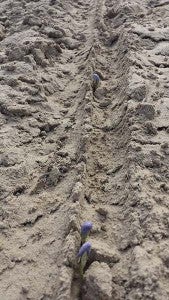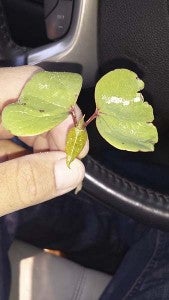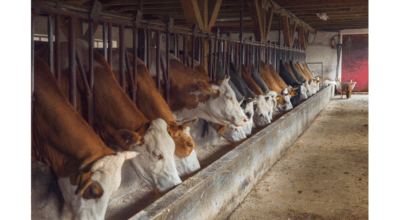Agronomist answers questions about growing cotton
Published 10:45 am Wednesday, July 2, 2014
by Chris Drake
I have been out of the business of writing articles since I left my office as the agriculture and natural resources agent for Southampton County in January. I guess the desire to inform the public about agriculture is embedded in my brain.

The purple that you see is cotton seedlings with the seed hull still attached just coming through the ground three and one-half days after planting. — SUBMITTED | CHRIS DRAKE
Since Feb. 1, I have been employed by Dow Agrosciences as an agronomist for their Phytogen brand of cottonseed. My job is to develop relationships at the farm level in order to maximize the producer’s success in cotton production. I am responsible for the cotton-growing counties in Virginia as well as 14 counties in neighboring North Carolina. Today, I will be wearing the hat of public information columnist.
I often wonder what the public thinks every time they see the large self-propelled sprayers in the fields. This is a common sight in southeast Virginia as we are home to about 80,000 acres of upland cotton. The topic of the first column in a series is a general overview of the early growing season of a cotton plant. Contrary to some opinions, growing a crop is far more than planting, waiting — for rain — and harvesting. There is immense research, experience and agronomic planning that goes into harvesting a bumper crop of cotton.
I know the average person must think we spray cotton continuously throughout the year. It is not uncommon to make 10 to 12 spray applications of insecticides, herbicides, plant growth regulators and defoliants. These decisions can make huge differences in the ultimate outcome of the crop.

This is the first true leaf emerging on a young cotton plant. The other two larger leaves are the cotyledons. This is the stage when farmers have to spray for thrips control. — Submitted | Chris Drake
The first decision and arguably the most important is variety selection. We have many varieties of cotton to choose from when planting season rolls around. Phytogen is the leading brand in this area in terms of sales, but we also have Stoneville, Deltapine, Fibermax, Americot and Dynagro. These brand names are all produced by very large companies everyone has heard of such as Monsanto and Bayer. The variety has to be chosen according to soil type, maturity and yield potential as well as trait packages. By traits I mean that we have several varieties available that are tolerant to applications of Roundup and Liberty. Liberty is a non-selective herbicide similar to Roundup, but it controls some weeds such as Palmer Amaranth and Marestails that have become resistant to Roundup application.
The presence of heavy weed pressure will dictate the variety in some cases, but usually yield potential is the main driving force behind variety selection. Farmers get paid for pounds of lint, thus yield potential is very crucial for success. Phytogen 499 is the most planted variety in Virginia and in the United States. The varieties that are planted in our area are adapted for success on sandy soils and are generally very early in maturity relative to others planted in the lower Southeast.
Our area is the northernmost cotton-producing region in the country. Cotton is planted on about 11.3 million acres in the United States with Texas, Georgia and North Carolina being the top three in terms of acres.
Once the variety is selected, we have to plant at the right time when soil moisture is adequate and soil temperature is high enough to facilitate germination of the seed. This occurs when soil temperatures are at 65 degrees or higher. We usually achieve this around the last week of April or early May. This year, a lot of cotton was planted from May 5-10. Cotton can be successfully planted into very early June, but we shoot for May planting dates to ensure full yield potential.
This year we had a great planting season for the most part with warm soils and adequate moisture. Cotton will emerge in three to five days in excellent conditions. Before or while cotton is planted we sow or inject nitrogen, phosphorous and potassium fertilizers based upon recommendations from soil sample tests done in the late fall or winter. These tests are done by Virginia Tech and N.C. State in conjunction with local extension offices. Southampton County sends no less than 3,500 samples per year to Blacksburg for analysis.
One question I often get is why we spray these fields in March and April with this stinking concoction. That smell you may encounter is 2-4 D herbicide being applied in addition to other residual herbicides to burn down Roundup resistant weeds such as Marestail aka horseweed. We generally apply these materials three to four weeks ahead of planting. This allows for a clean weed-free start.
The 2-4 D is commonly used by homeowners in various over-the-counter box store products to kill lawn weeds such as buttercups and chickweed. It is a great broadleaf weed-killing material that has many uses in modern agriculture. You may ask what a residual herbicide is. We apply materials that might not necessarily kill emerged weeds, but they form a soil barrier that will kill weeds as they try to emerge through the soil. Valor is the name of a common material we use to prevent troublesome weeds from hindering our young cotton’s progress. We also apply herbicides right after planting to burn down any escaped weeds and to add an additional residual barrier. Many people may be familiar with landscape products like Preen that, while different in chemistry, it provides the same herbicide soil barrier to keep the flower beds clean.
Once we have the cotton up and growing, the fun is just beginning for farmer’s and crop advisors. The first battle we fight is thrips. Thrips are an insect pest that damage young seedlings often causing significant yield losses if not controlled with insecticide applications.
The first true leaf should start to emerge a few days after the cotton has come out of the ground. Thrips will attack young plants and damage the newly forming leaves. We will then spray the cotton to control the thrips populations with acephate-based insecticides. Homeowners and gardeners often deal with these insects as well. Thrips are very common in tomatoes and will cause the leaves to curl/crinkle and can lead to Tomato Spotted Wilt Virus. In addition to the insecticide, many farmers will add Roundup to the tank to control early emerged grass or weeds.
After all that is done, we hope for warm days and periodic rainfall to keep the plants growing vigorously. Early season vigor is a trait that farmers look for in a variety. Phytogen 499, Phytogen 333, and a few other varieties are noted to be extremely strong out of the gate in terms of seedling vigor. We have been blessed so far in 2014 with good conditions to push our cotton crop along nicely in terms of growth. I know from 37 years of living with a farmer — as well as being one — that complaining about the weather is a staple at the dinner table. We live in coastal plain soils that are sandy in nature. Thus, we are never more than 10 days away from drought conditions. We can have a “frog strangler” today and two weeks from now it may be dry as a bone. Also, spotty showers bless some farmers while leaving others desperately praying for that million dollar rain storm. We need rain throughout the growing season to facilitate vegetative growth and reproductive fruiting processes. It will be critical in July and August when the cotton is blooming to receive timely rain showers to retain this fruit that will soon become a fluffy boll of white fabric.
In the next column, I will describe what it takes to manage a cotton crop in July and early August. In the meantime, we pray for afternoon showers to bless us all. I hope by the end of the year that as you ride through southeastern Virginia and see the farmers spray their cotton fields, you will know exactly why they are doing what they are doing. It is all a process to ensure quality cotton is produced to clothe the world. Until then, keep your eyes to the sky and cotton on your back.
CHRIS DRAKE is the territory agronomist for Phytogen Cottonseed in Southeast Virginia and Northeast North Carolina and the former Southampton County Extension agent. He can be reached at chrisdrake1717@gmail.com.





